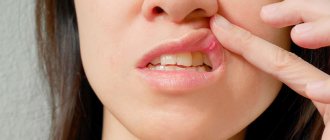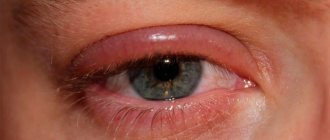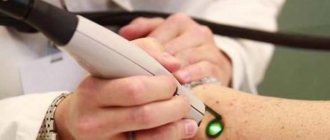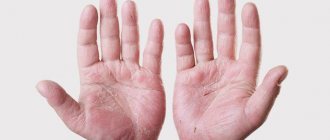The condition of the oral mucosa is one of the indicators of human health. It is involved in most pathological processes occurring in the body and reacts even to minor changes in the microbial composition of the oral cavity. Therefore, many people have experienced red dots on their gums and palate at least once in their lives. This is a natural reaction to mechanical and temperature stimuli. Redness may be caused by:
- consumption of hot and spicy foods and drinks;
- damage to soft tissues with a hard brush, toothpick, bones and pieces of hard food;
- Using the wrong toothpaste or mouthwash;
- wearing prostheses, braces, retention caps.
However, red spots can also indicate various diseases. Let's look at the most common cases.
Types of stomatitis
Depending on the nature of the disease and its clinical manifestations, experts divide catarrhal, catarrhal-hemorrhagic, as well as bullous, erosive, ulcerative-necrotic and allergic stomatitis.
The latter, in turn, is divided into the following types:
- medicinal;
- contact, for example, as an allergy to dentures, braces, plates;
- catarrhal;
- catarrhal-hemorrhagic;
- ulcerative-necrotic;
- erosive.
From the point of view of etiology and pathogenesis, allergic stomatitis includes medication, contact (including dentures), toxic-allergic, autoimmune dermatostomatitis, chronic recurrent aphthous stomatitis and other forms.
Depending on the speed of development of the reaction, doctors distinguish immediate and delayed types of allergic stomatitis. In the first case, angioedema is observed, and in the delayed type, the reaction to a particular irritant usually appears a few days after contact with the allergen.
In rare cases, allergic stomatitis develops while wearing dentures. Sometimes a reaction occurs even after 5–10 years of wearing them, after a long asymptomatic period.
Ask a Question
Causes of the disease
As is clear from the name of the disease, a negative reaction of the body develops after contact with various allergens. Most often, allergic stomatitis occurs after contact with plant pollen or mold spores. The disease can also manifest itself against the background of:
- installation of crowns, fillings, prostheses made of low-quality materials;
- consumption of certain types of food (especially in children);
- decreased immunity;
- course of treatment with antibacterial drugs or sulfonamides;
- advanced caries;
- bleeding gums;
- inflammation of the oral cavity;
- proliferation of pathogenic microorganisms in the oral cavity.
Sometimes allergic stomatitis manifests itself as a complication of Lyme disease, systemic lupus erythematosus, aphthous stomatitis, hemorrhagic diathesis, and Stevens-Johnson syndrome.
What causes the appearance of rashes
- viruses that cause diseases of the upper respiratory tract;
- influenza virus;
- Epstein-Barr virus (causative agent of mononucleosis);
- adenovirus;
- enterovirus HSV - 1 (virus that causes herpetic sore throat).
If infected with any of these viruses, the ciliated epithelium lining the upper respiratory tract is affected.
Of the bacterial microorganisms that can cause the symptom of “red throat,” the most common is streptococcus A (GAS). This is practically the only bacterium that can infect the throat. This is what causes streptococcal sore throat.
- Encyclopedia of rashes - 2
Symptoms
The disease is characterized by general and local symptoms. The first symptoms of a mild form of allergic stomatitis are:
- slight discomfort in the oral cavity during hygiene procedures and eating;
- inflammation and swelling of tissues;
- redness and itching of the affected areas of the mucous membrane;
- excessive salivation.
If allergic stomatitis began while taking certain medications, the patient complains of painful blisters filled with liquid. Tick-borne borreliosis is accompanied by redness, blisters on the mucous membranes, as well as bleeding erosions and wounds.
Allergic stomatitis without proper treatment develops very quickly: the patient’s body temperature rises, and bubbles and blisters appear on the skin, mucous membranes of the eyes, and genitals.
If the disease was caused by Lyme disease, red spots with a border appear in different parts of the body and are very painful. Sometimes patients complain of joint pain.
Angina
Herpetic sore throat is also a fairly common cause of the formation of red dots in the throat on the roof of the mouth. The disease is characterized by high fever that lasts for several days, pain when swallowing, discomfort in the abdomen, and enlarged lymph nodes.
Streptococcal sore throat is accompanied by general malaise, headache, and high body temperature. The tonsils become loose and covered with plaque. In this case, antibiotic therapy is used, but the treatment regimen must be drawn up by a qualified specialist.
Diagnostics
The diagnosis of “allergic stomatitis” is made by a dentist based on an examination of the oral cavity and questioning the patient about underlying diseases and medication use. The dentist clarifies the clinical picture of the disease.
The doctor must conduct a comprehensive examination and diagnosis:
- removable and fixed prostheses;
- braces;
- filling
To clarify the clinical picture of the disease, the specialist refers the patient for a comprehensive blood and urine test and an immunogram to assess the state of the immune system. If necessary, the doctor sends the patient for the following studies:
- determination of the acidity level and composition of saliva;
- identification of the activity of enzymes contained in saliva;
- leukopenic test;
- provocative tests with removal and subsequent installation of prostheses.
An integrated approach to diagnosing allergic stomatitis will allow you to quickly find out the cause of the negative reaction, eliminate it and begin effective treatment.
Other reasons for finding red dots in the sky
Red dots on the upper palate may be the result of the following rare diseases:
Pyogenic granuloma
Occurs in a place often subject to trauma. It is necessary to excise the tumors at the root, after which electrocoagulation therapy is prescribed.
Kaposi's sarcoma
It is a malignant neoplasm with a purple hue. Local chemotherapy is prescribed, and measures are taken to increase the patient’s immunity.
Pathechia in the sky
These are small flat spots that often appear during mononucleosis. May be a manifestation of smallpox, thrombocytopenia, typhoid fever and endocarditis.
If a red rash occurs in the mouth, you do not need to make a diagnosis and prescribe treatment yourself.
It is necessary to consult with a specialist, find out the cause of the spots and receive appropriate treatment. The DentalGuru dental clinic employs experienced and professional dentists who guarantee painless and effective treatment of stomatitis and other dental diseases. This article is for informational purposes only, please consult your doctor for details!
Treatment of allergic stomatitis in adults
If the dentist confirms the diagnosis, he first prescribes complex therapy. It is important not only to eliminate the painful external manifestations of the disease, but also to adjust drug treatment, change the patient’s lifestyle and, if necessary, discontinue medications that caused irritation.
Folk remedies are excellent aids in treating the disease, but using herbal infusions alone will not completely get rid of the disease. The main thing is to determine the cause of the allergy and eliminate it as soon as possible.
The main directions in the treatment of stomatitis are:
- identification and elimination of allergens;
- selection of suitable orthopedic structures (if an allergy to them is identified);
- replacement of low-quality fillings;
- selection of softer and more gentle medications;
- taking antihistamines and antiallergic drugs;
- use of local antiseptics and painkillers;
- disinfection of mucous membranes by rinsing in order to reduce the risk of infection spreading through the bloodstream throughout the body;
- taking analgesics and anti-inflammatory drugs.
Treatment of allergic stomatitis necessarily includes a hypoallergenic diet. In order for the aphthae to heal as soon as possible, and the patient no longer suffers from painful sensations in the oral cavity, the following should be excluded from the diet during treatment:
- sour, spicy and salty foods;
- citrus;
- fried foods;
- peppered dishes.
During treatment, it is recommended to eat soft foods, such as purees or soups. It is important not to injure the affected and swollen mucosa, so that the wounds heal as soon as possible and the swollen mucosa is not injured.
Additional treatment
As prescribed by the dentist and allergist, the patient can use various herbal decoctions and healing oils as additional treatment. The most effective recipes are:
- Aloe juice. The juice of the plant perfectly relieves inflammation, heals ulcers and wounds. You can rinse your mouth with the fresh juice, or you can chew the pulp of the fleshy leaf, peeled.
- Sea buckthorn oil . This oil can treat stomatitis of any form, including allergic ones. You can prepare the oil yourself or buy it at a pharmacy. To supplement the treatment, it is enough to lubricate the affected tissues several times a day. Sea buckthorn will heal wounds, soften the mucous membrane and reduce inflammation.
- Propolis . This beekeeping product perfectly relieves inflammation and heals ulcers and wounds, and also perfectly disinfects the mucous membrane. To treat stomatitis, it is enough to dilute a pharmaceutical tincture of propolis in water in a ratio of 1:10 and rinse your mouth with it.
- Chamomile infusion has excellent anti-inflammatory and wound healing properties. To treat the oral cavity, just pour 2 tablespoons of flowers into a thermos, pour 1 liter of boiling water into them and let it brew for 45 minutes. It is recommended to rinse your mouth with filtered infusion 3-4 times a day. Instead of chamomile, you can use an infusion of sage or calendula, and also prepare a mix, taking a teaspoon of each herb.
How is inflammation of the palate treated?
How to treat inflammation on the roof of the mouth, a specialist will tell you after determining the diagnosis. The following therapy methods can be used:
- If the cause of inflammation is minor damage to the mucous membrane, rinsing with decoctions of medicinal herbs is usually sufficient. Decoctions and infusions based on calendula, sage and chamomile have an antiseptic and healing effect. The herbal decoction for rinsing should be used warm.
- When the palate is affected by a fungus, patients are prescribed topical agents. The most effective are the solution and gel “Chlorhexidine”, “Rotokan” or “Stomatofit”.
- In case of severe pain symptoms, regardless of the cause of inflammation, drugs of combined action are prescribed. “Cholisal-gel” and “Kalgel” have proven themselves well.
- If a purulent inflammatory process is detected in the oral cavity, the patient is prescribed antibiotics. The minimum course of treatment is usually 7 days, but there are also stronger drugs that only need to be taken for 3 days. Along with local agents, antibacterial drugs for internal use - Sumamed, Flemoxin Solutab - can be prescribed.
- The inflammatory process of the palate is easily treatable. The earlier therapy is carried out, the less likely it is to develop complications.
Allergic stomatitis in children
In children, the disease occurs more often than in adults, and at the same time, a weak and fragile child’s body reacts more sharply to irritants. The baby begins to be capricious, complain of pain in the mouth and, of course, is afraid to go to the dentist.
In no case should parents let a child’s illness take its course, relying on traditional methods of treatment. If the baby suffers from allergic stomatitis, no ointments or rinses will cure him 100% as long as contact with the allergen continues. Sensitive thin mucous membranes easily crack, bleed, and pathogenic microorganisms quickly penetrate into the ulcers.
It is important to take the child to a specialist as soon as possible, explain to him that the doctor will help him get rid of the pain, and begin the examination.
What causes red dots in the sky?
Experts identify several factors that contribute to the appearance of red dots on the palate in a child or adult:
- Pathological processes in the circulatory system and vessels.
- Infectious diseases.
- Allergic reaction.
- Rare diseases.
Based on the causes and individual characteristics of the body, a red rash can appear either once in a lifetime or quite often. If spots appear repeatedly, then we can talk about herpes viruses, thrush or enteroviral infections.
When exposed to infection, in addition to red dots on the palate, the child’s temperature rises, pain in the throat and larynx appears, weakness, and it becomes painful to swallow. The rash affects not only the palate, but also the tongue, as well as the inside of the cheeks. Infections that cause a rash include:
- Flu.
- Roseola.
- Scarlet fever.
- Meningitis.
- Typhus.
- Rubella.
- Staphylococcal infections.
- Chickenpox.
- Mononucleosis.
- Erythema.
- Syphilis.
Children suffer from chickenpox, rubella and scarlet fever in a milder form than adults, receiving immunity for life. In adults, these diseases occur with complications. But coping with herpes sore throat and stomatitis is much more difficult for children. These diseases progress quickly and greatly worsen the child’s condition.
Prevention of allergic stomatitis
Unfortunately, patients are not always able to prevent the development of allergic stomatitis. It is impossible to predict what the oral cavity's reaction to a foreign substance will be. If an immune reaction is suspected, the dentist may refer the patient to an allergist.
The main measures to prevent allergic stomatitis are timely visits to the dentist and treatment of caries, strengthening the immune system and using suitable products for daily oral hygiene. If detected early, the pathology can be successfully treated.
If you suspect that you or your child have allergic stomatitis, experience pain in the oral cavity, or find ulcers and aphthae on the mucous membrane, do not delay consulting a doctor. Experienced dentists at STOMA clinics will help you determine the source of allergic stomatitis, quickly get rid of the unpleasant manifestations of the disease and return to your normal life.
We will check all structures in the patient’s oral cavity, conduct allergy tests, and, if necessary, refer the patient to trusted allergists and other specialists.
Call and make an appointment by phone. STOMA clinics are open from Monday to Saturday. You can choose a conveniently located clinic; we are open in many districts of St. Petersburg.
Treatment of glossitis of the tongue
First of all, the treatment plan depends on the type of inflammation. It is compiled individually, based on clinical and diagnostic data. For acute catarrhal glossitis, it is important to remove the irritating factor: replace the crowns or, conversely, put crowns on the damaged tooth. Change your eating habits, stop chewing nuts, hard candies, and crackers.
For a folded tongue, oral hygiene comes to the fore.
If lumps and papillomas grow during rhomboid glossitis, they are excised. Laser surgery allows you to do this quickly, with virtually no blood.
The main recommendation for black tongue is treatment of somatic diseases and smoking cessation. Liquid nitrogen is used to remove papillae, as well as applications to keratinized areas.
But there is a general approach to treatment:
- sanitation of the oral cavity;
- professional teeth cleaning;
- vitamin complexes;
- iron supplements for anemia;
- for pain - light anesthetics in the form of applications;
- for burning - oral baths and irrigation;
- physiotherapeutic procedures;
- checking for fungal infections.
There are many recommendations on the Internet for treating glossitis with folk remedies. No one disputes the anti-inflammatory properties of chamomile, sage and plantain. When a spot appears on the tongue, applications of sea buckthorn oil and aloe juice can bring relief. But these measures are temporary, they affect the symptoms, but the cause of the disease remains unattended. As a result, it is easy to miss the point when it was not difficult to fix the problem.
Glossitis is closely related to common diseases and psychological causes. Effective treatment is only possible using an integrated approach. How to treat glossitis and what examinations you need to undergo can only be advised by a qualified doctor. Glossitis can be cured quite quickly, but if left untreated, abscesses, tumors, and necrotic tissue changes can form. This is much more serious and the prognosis is not so favorable.











